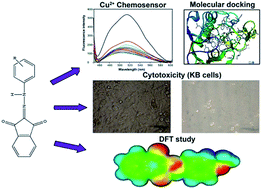Twin applications of highly selective Cu2+ fluorescent chemosensor and cytotoxicity of 2-(2-phenylhydrazono)-1H-indene-1,3(2H)-dione and 2-(2-(4-methoxyphenyl)hydrazono)-1H-indene-1,3(2H)-dione: molecular docking and DFT studies†
Abstract
Fluorescent chemosensors based on 2-(2-phenylhydrazono)-1H-indene-1,3(2H)-dione (1) and 2-(2-(4-methoxyphenyl)hydrazono)-1H-indene-1,3(2H)-dione (2) with high sensitivity and selectivity toward paramagnetic Cu2+ were developed over other cations. The Cu2+-induced fluorescence turn-on mechanism was revealed to be mediated by intramolecular charge transfer from the ligand to the metal. The compounds were characterized by UV-vis, FT-IR, 1H and 13C NMR techniques, scanning electron microscopy (SEM), energy dispersive spectroscopy (EDS), elemental color mapping and fluorescence spectroscopy. Morphology changes of compounds (1) and (2) to complex with Cu2+ were also investigated by SEM. EDS analysis exposed the occurrence of copper in complexes. Elemental color mapping also supported the copper present in the complexes of corresponding compounds (1) and (2). The metal sensing (chemosensing) properties of compounds (1) and (2) were also examined via fluorescence spectroscopy. The sensor showed excellent selectivity with fluorescence enhancement to copper over other cations in ethanolic solution. The chelating functionality of compounds (1) and (2) was evaluated for inhibitory properties against various human cancer proteins like 4LRH, 4EKD, 4GIW and 4L9K using an online docking server. The cytotoxicity study demonstrated the ability of compounds (1) and (2) to inhibit the growth of KB cell lines. Combined experimental and theoretical studies were carried out on the molecular structure using density functional methods (B3LYP) invoking the 6-31G basis set. The density functional theory (DFT) calculation was carried out for both compounds. Energy of the highest occupied molecular (HOMO) orbital and lowest unoccupied (LUMO) molecular orbitals were predicted.


 Please wait while we load your content...
Please wait while we load your content...